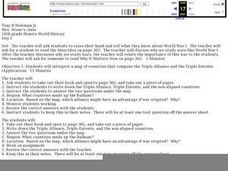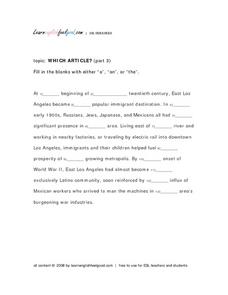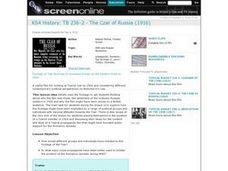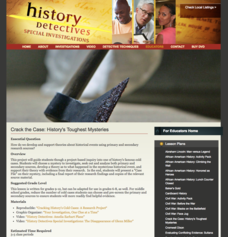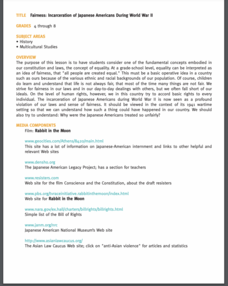Curated OER
The Tet Offensive and the Vietnam War
Students comprehend how the United States became involved in what one historian called the quagmire. Students identify and analyze the importance of the Tet Offensive in turning American public opinion against the Vietnam War. Students...
Curated OER
War & Peace
In this social studies worksheet, students find the words that are used to describe war and peace times .The answers are found at the bottom of the page.
Curated OER
Three Wars Equal One New Country: Part 1
Students explore how and why Germany became a nation.
Curated OER
Sow the Seeds of Victory! Posters from the Food Administration During World War I
Students engage in a class analysis of posters, responding to each of the worksheet questions. They identify the similarities and differences between the posters.
Curated OER
World War II Time Line
Young scholars locate information on WWII in reference books. They as a group place key events of WWII in appropriate sequence on a time line and discuss key events that occurred during WWII as a class.
Curated OER
WWI for World History Honors
Using a textbook, learners will examine various aspects related to the Triple Alliance of WWI. They complete a series of handouts, engage in a class discussion, and interpret a map showing both the Triple Alliance and the Triple Entente....
Curated OER
Which Article? (Part 3)
Use this worksheet to have learners fill in thirteen blanks in a descriptive paragraph with the grammatically correct articles for each one.
Curated OER
The July Crisis: Can You Stop the Great War?
Learners role-play as diplomats from countries involved in World War I who have received telegrams stating they must prepare presentations on their country's position about the war. They have 45 minutes to reach a peace accord, or they...
Curated OER
Exploring War Themes in Art and Poetry
What is war? Students discuss the ethical dilemma of war by viewing Picasso's painting entitled "Guernica" and write down everything they see in the painting. Then they choose one emotion that best summarizes their emotional response to...
Curated OER
Never To Forget
Tenth graders discuss the events leading up to antisemitic behavior in Europe during World War II. Through various activities, 10th graders acquaint themselves with the political ideology of Nazism and assess responsibility for the...
Curated OER
Until Then I Had Only Read About These Things in Books
Students read assigned text about the World War II. In this Holocaust survival lesson, students identify the mass murders associated with Adolf Hitler's Nazi party and read stories of young men who narrowly avoided the death camps....
Curated OER
The Technological Impact on 1950's Culture
Students examine the impact of technological advancements on Cold War America. In this 1950's America lesson, students research politics, Cold War society, suburbia, and consumerism during the decade in order to better understand...
Curated OER
WWI and Russian Revolution
Students view and discuss footage of Tsar Nicholas II reviewing troops on the Eastern Front in 1916 and examine how different groups would have reacted to this footage of the Tsar. They watch the video and in small groups answer...
Curated OER
The Diary of Anne Frank
Sixth graders explore journal writing. In this writing lesson, 6th graders use the published diaries of Anne Frank and discuss the entries in her journal. Students write in their own journal for a week and create a one page summary on...
Curated OER
Propaganda, WWII, Ghetto‘s, and Analysis of Primary Resources
Students consider the implications of anti-Semitism. In this World War II lesson, students examine selected documents and images featuring the propaganda that promoted Jewish persecution. Students write essays that highlight how the Nazi...
Curated OER
Flying Against The Wind
Eighth graders discuss the various actions of non-Jewish Germans during World War II. Through various readings and activities, they explore the rejection of Nazi ideology and how many German citizens worked to help Jewish citizens during...
Curated OER
Always Remember, or Eventually Forget
Students examine one writer's opinion about how different generations of Japanese citizens have been influenced by the bombings of Hiroshima and Nagasaki.
Curated OER
A Colony is Born : Lesson 6 -To Leave or Not to Leave
Fifth graders connect reasons for coming to the New World with identity. The create identities and place them in one of three settled regions. They refer to prior study notes in their Colonial Notebooks to establish their identities.
Curated OER
Anne Frank: The Island of the Skog
Learners read and discuss The Island of the Skog by Steven Kellogg and examine the illustrations, keep a "discrimination log," and write about one example of discrimination and how they could have intervened to stop it.
PBS
Crack the Case: History's Toughest Mysteries
Young sleuths don their trench coats, tip their fedoras, and grab their notepads to investigate one of four famous unsolved mysteries. After examining multiple primary and secondary sources related to their cold case, they propose a...
Curated OER
Children at War
Students conduct Internet research to investigate the use of children in combat throughout the world. Students read personal testimonies and analyze media coverage of children in combat.
Curated OER
Genocide in World War II
Students access a variety of websites that explore the Nazi German genocide of Jews in WWII. They view a film, complete a worksheet and write an opinion paper supporting the view to either punish or forgive the perpetrators of crimes...
Curated OER
Fairness: Incarceration of Japanese Americans During World War II
Young scholars examine fairness in relation to the incarceration of Japanese Americans during WWII. In this equality instructional activity, students watch a video "Rabbit in the Moon" and discuss what happened to the Japanese Americans...
Curated OER
Number the Stars by Lois Lowry : Art Activity
In this reading response worksheet, learners create a word of art depicting a scene in Lois Lowry's novel Number the Stars. Students use lead pencils or charcoal to make a picture in black and white because color photography was not...







